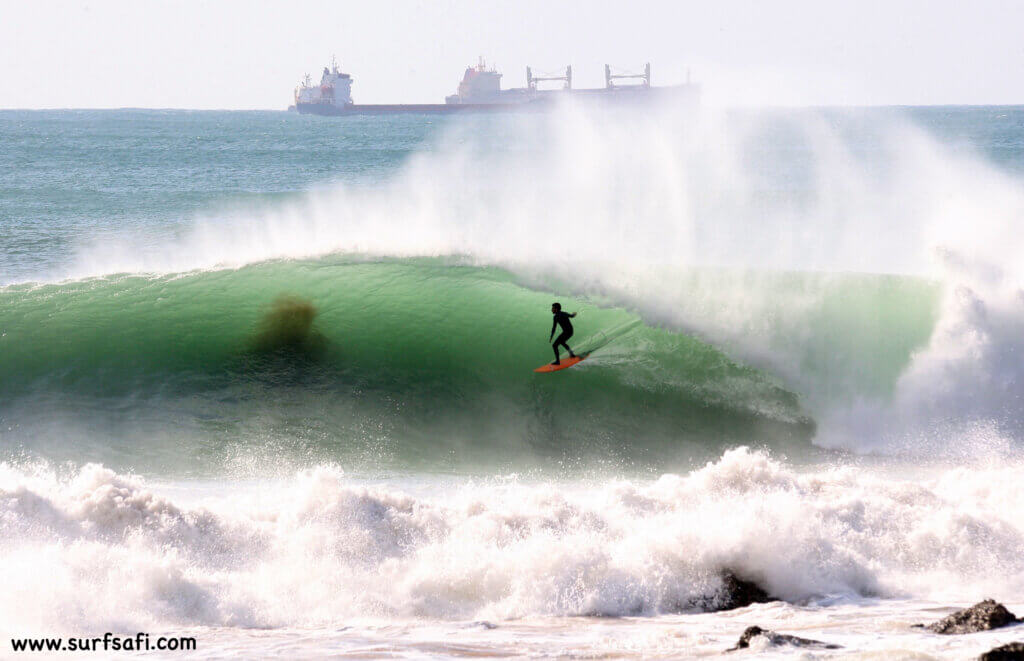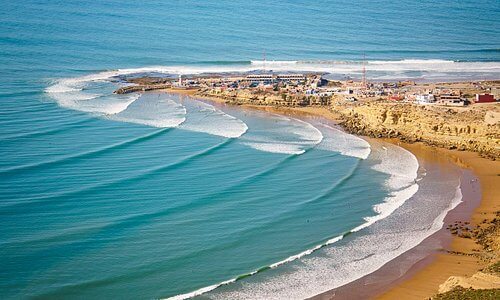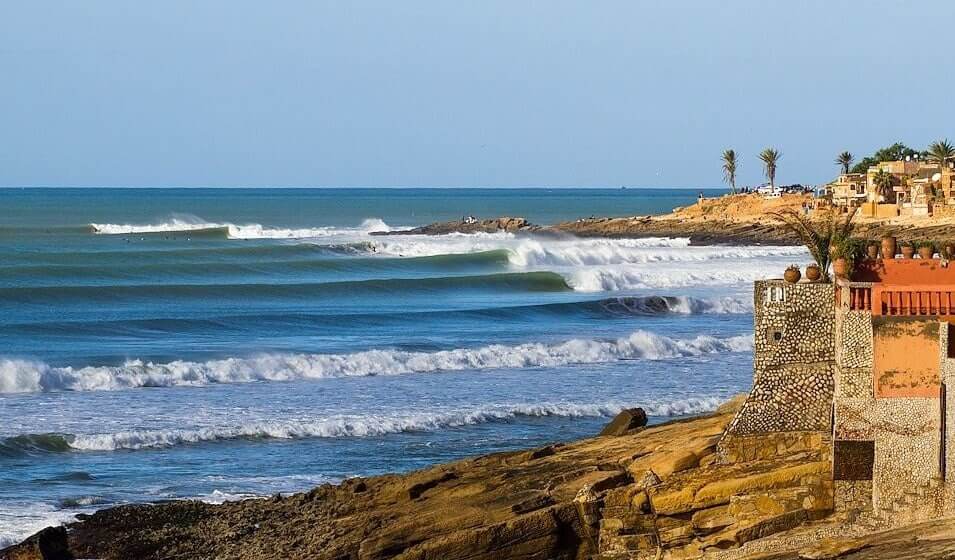When the season ends here, in Biarritz, it starts again there.
We come back and frankly, it’s worth the diversions!
3 REASONS WHY IT IS A GOOD WINTER SURFING DESTINATION
-
MORE SHELTERED FROM THE SWELL
- MORE SHELTERED FROM THE WIND
- SUMMER TEMPERATURES
While the Atlantic beaches are hit by winter depressions, the Moroccan west coast is more protected from bad weather.
Last week, we decided to escape the Agate storm that hit the whole of France and believe me, we did well!
When we arrived in Imsouane, a small bay in the west of Morocco, summer temperatures were waiting for us.
The temperatures remained quite cool at sunrise and at nightfall but as soon as the sun came out, we were wearing shorts and swimming costumes!
With few exceptions, the wind was constantly offshore, giving us great waves.
In spite of the storm nearby, the size of the waves remained decent (1m50 to 3 meters) on the most exposed spots for the greatest happiness of the good surfers, and this all along the coast!
For the less experienced, there are some fallback spots offering waves of a more than affordable size: 80 cm to 1m.
When you think that at home you were more on 5m with gusts at 100 km/h…. it’s very pleasant !
THE SPOTS TO BE PRIVILEGED
Almost all the west coast is surfable in Morocco!
SAFI

Further north, towards Casablanca, the small fisherman’s town has one of the best waves in the world.
Capricious, this wave only works in precise conditions of swell (size and orientation) and tidal coefficients.
But when it works, it delights most of the surfers who love tubes.
Beware, this wave is indeed reserved for experienced surfers! The wave is powerful, tubular and the localism is strong.
Don’t hesitate to ask for information before going there. The wave is hidden, better know where you put your feet.
For spectators and photographers, there is also plenty to do!
And if you’re tired of watching other people surf, go and visit the town. Safi is famous for its pottery kilns. Almost all the pottery in Morocco comes from there. The atmosphere is traditional and warm.
IMSOUANE
Heading South! After a winding journey through the Moroccan cliffs, you will reach the village of Imsouane.
A fishermen’s port since time immemorial, this small town has quickly exploded due to its attraction for surfers, especially longboarders!
If the spot of Cathédrale, on the right of the bay, offers waves worthy of the beach breaks we know in France, the wave of “la baie” looks like a giant wave pool!

If you start from the peak, you will take the longest right of your life! Your legs will hurt when you get to the bottom!
If you don’t manage to take it from the peak, don’t panic, the wave reforms on 4 different sections!
It is flat, which favours longboard surfing but it can also be surfed with a small board and practice its cut backs!
Beware of the crowd though… Like many longboard waves, the Imsouane wave is known as a wave for beginners. So there are people everywhere…. Really everywhere! And many don’t seem to know what they are doing.
So the atmosphere in the water can sometimes take a hit too.
ANCHOR POINT or the famous anchor point in French.

About 1 hour south of Imsouane bay, this mythical wave is preceded by its reputation. It is one of those spots that surfers must surf at least once in their lives.
The spectacle is grandiose!
But beware of localism. This wave is not for beginners either, unless the swell is small.
For beginners, you can easily surf all the spots south of Anchors Point or Banana Village.
Other nearby spots are also very good for surfing: boilers, devil’s rock, la source and Anza.
DAKHLA
Lesser known surf spots further south will also delight surfers!
More exposed to the swell, it is better to go there at the beginning and during the summer.

WHAT TYPE OF WETSUIT SHOULD YOU BRING?
It’s difficult to decide what thickness of wetsuit to choose… Especially as with low cost flights you don’t have much room in your suitcase, and the water temperatures can vary from one year to the next.
Indeed, the outside temperatures are quite cool in the morning and evening and rather warm during the day.
The 4.3 is very popular for morning or sunset sessions. The 3.2 is more suitable for daytime sessions.
If you have to choose one or the other, it will depend on your resistance to the cold!
In any case, from October to December, the water temperature varies between 17 and 20 degrees.
HOW TO GET TO MORROCCO?
There are many flights from France to Morocco!
The closest airport to the most popular spots is Agadir: just 40 minutes from Taghazout, 2 hours from Imsouane.
For shopping enthusiasts, you can also easily get there via Marrakech; allow about 3h to 3h30.
Flights there are generally very cheap from Bordeaux, Lyon or Paris.
In short, if you haven’t tried it yet, we recommend +++ This destination is, in our opinion, the one that offers the most change of scenery in the least amount of time and money if you’re looking for warmth, good waves, and a culture different from ours!




